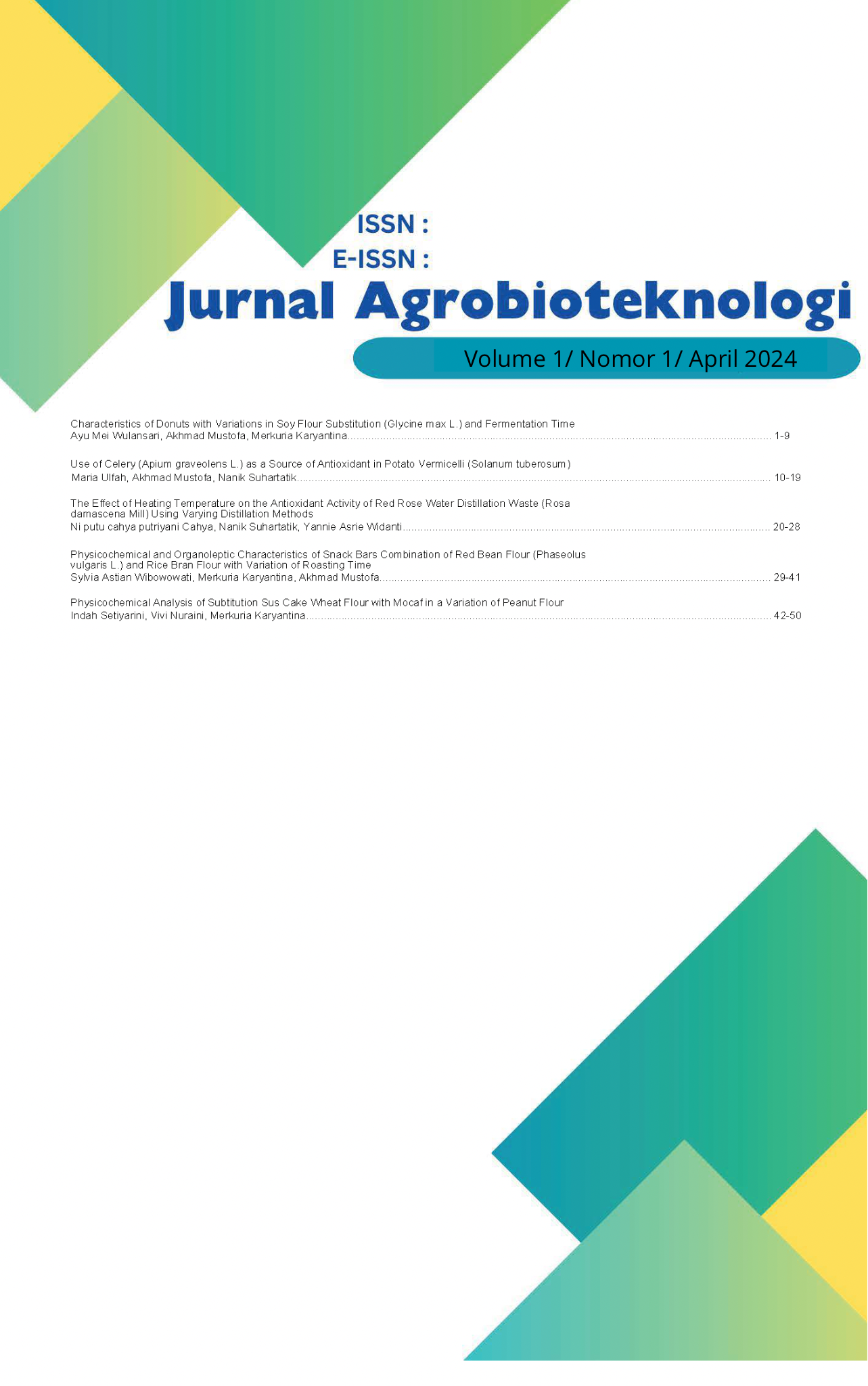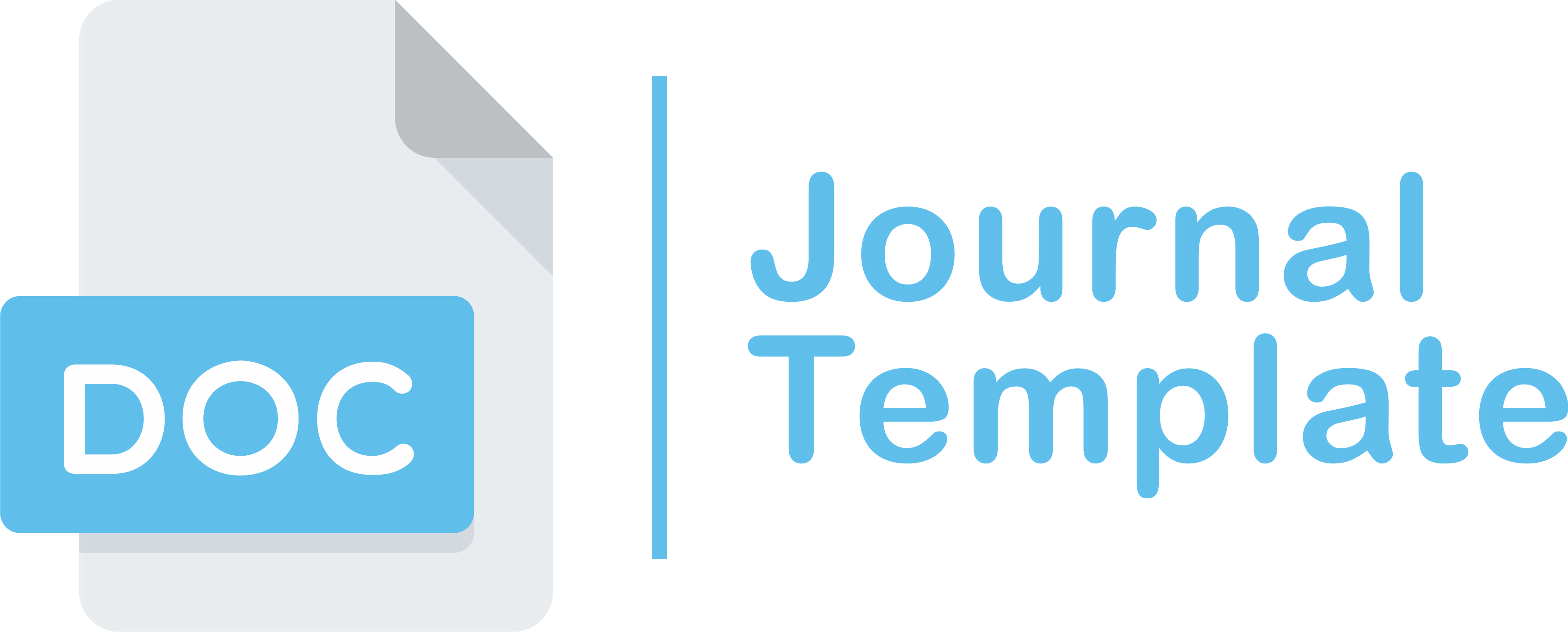The Effect of Heating Temperature on the Antioxidant Activity of Red Rose Water Distillation Waste (Rosa damascena Mill) Using Varying Distillation Methods
Pengaruh Suhu Pemanasan terhadap Aktivitas Antioksidan Limbah Penyulingan Air Mawar Merah (Rosa damascena Mill) Dengan Variasi Metode Destilas
DOI:
https://doi.org/10.33061/agrobiotek.v1i1.9822Abstract
Red rose (Rosa damascena Mill) is one of the plant that can be easily found in Indonesia. The corolla of red roses contains natural dyes, namely anthocyanins which can be used as food coloring and the function as antioxidants or counteract free radicals. The corrola of red roses is used as a raw material in distillation of rose water. Rose water distillation poduces is a dark red liquid. This liquid waste has not been utilized optimally. Therefore, that further research is needed to determine the chemical content in it. So that the expected outcome of this research is the best chemical and sensory analysis of red rose water distillation waste based on it's antioxidant activity. The research design used a 2 factor factorial completely randomized design (CRD). The first factor is the variation of the distillation method while the second factor is the heating temperature of the red rose water waste (heated waste). The optimal treatment result was a combination of steam distillation method variations and 70°C heating temperature with following results obtained : 77,32% RSH DPPH, 61,02% FRAP value, 71,20 mg/g vitamin C, 4,58 mg total phenol.GAE/ g, pH 4,15, anthocyanin 121,93 mg/g, brightness 27,23 (*L), red-green chromatic 7,13 (*a), blue-yellow chromatic 7,54 (*b). Sensory analysis of color was 4.36 (deep red), other scents were 2.47 (slightly sour), rose aroma was 3.64 (strong), and overall preference was 3.75 (liked).
References
A’yunin, N. A. Q., Santoso, U., &
Harmayani, E. (2019). Kajian kualitas dan aktivitas antioksidan berbagai formula minuman jamu kunyit asam. Jurnal Teknologi Pertanian Andalas, 23(1), 1410–1920.
Cahyati, S., Kurniasih, Y., & Khery, Y. (2008). Efisiensi pemisahan minyak atsiri dari kulit jeruk dengan Sampel dengan metode penyulingan air-uap ditinjau dari perbandingan bahan baku dan pelarut yang difungsikan. Jurnal Ilmiah Pendidikan Kimia “Hydrogen†4(2), 103–110.
Choiriyah, N. A. (2020). Muatan antioksidan pada berbagai bunga edible di Indonesia. Agrisaintifika: Jurnal Ilmu-Ilmu Pertanian, 4(2), 136.
Christian, M. (2011). Pengolahan banana bars dengan inulin sebagai alternatif pangan darurat. [Skripsi]. Bogor, Indonesia: IPB (Pp.34).
Gupita, C. N., & Rahayuni, A. (2012). Pengaruh berbagai pH sari buah dan temperatur pasteurisasi terhadap aktivitas antioksidan dan taraf penerimaan sari kulit buah manggis. Journal of Nutrition College, 1(1), 209–215.
Khasanah, L.U., Fathinatullabibah, &
Kawiji. (2014). Stabilitas antosianin Ekstrak Daun Jati (Tectona grandis) terhadap Perlakuan pH dan Suhu. Jurnal Aplikasi Teknologi Pangan 3 (2), 3(2), 60-63.
Kurniati,D., Arifin, H. R., Ciptanngtyas,
D., 7 Windarningsih, F. (2019). Kajiam Pengaruh Pemanasan terhadap Aktivitas Antioksidan Buah Mengkudu ( Morinda Citrifolia) sebagai Alternatif Sumber Pangan Fungsional. Jurnal Teknologi Pangan, 3 (1), 20-25.
Maesaroh, K., Kurnia, D., & Al Anshori,
J(2018). Perbandingan metode uji aktivitas antioksidan DPPH, FRAP dan FIC Terhadap asam askorbat, asam galat dan kuersetin. Chimica et Natura Acta, 6(2), 93.
Malasari, N., Sutamihardja, R., & Syawaalz, A. (2017). Uji sifat fisika-kimia dan identifikasi fenil etil alkohol minyak atsiri bunga mawar hasil ekstraksi pelarut. Jurnal Sains Natural Universitas Nusa Bangsa, 7(2), 91–103.
Marjoni, M. R., Afrinaldi, & Novita, A. D. (2015). Muatan total fenol dan aktivitas antioksidan ekstrak air daun kersen (Muntingia calabura L.). Jurnal Kedokteran YARSI, 23(3), 187–196.
Nainggolan, B. (2013). Sintesis derivat limonen muatan minyak kulit buah jeruk sunkist (Citrus aurantium). Jurnal Pendidikan Science, 26(2), 11–19.
Narsih, & Agato. (2018). Efek kombinasi temperatur dan waktu ekstraksi terhadap komponen senyawa ekstrak kulit lidah buaya. Jurnal Galung Tropika, 7(1), 75.
Nurlela. (2011). Ekstraksi dan uji stabilitas zat warna alami dari bunga kembang sepatu (Hibiscus rosa-sinensis L) dan bunga rosella (Hibiscus sabdarifa L). [Skripsi]. Jakarta, Indonesia: Universitas Islam Negeri Syarif Hidayatullah. (pp. 11–12).
Pradana, A. O., Pertiwi, R., Suhono, F. E., & Mustofa, A. (2019). Stevia (Stevia rebaudiana) aplication on wedang semir (secang and gambir) as natural sweetener. Pengembangan Pangan Fungsional Berbasis Sumber Daya Lokal Menuju Ketahanan Pangan, 46–51.
Priska, M., Peni, N., Carvallo, L., & Ngapa, Y. D. (2018). Review: Antosianin dan pemanfaatannya. Cakra Kimia (Indonesian E-Journal of Applied Chemistry), 6(2), 79–98.
Rahmah, L., & Kristiastuti, D. (2016). Pengaruh subtitusi tepung mocaf (modified cassava flour) dan penambahan puree daun ginseng (Talinum triangulare) terhadap sifat organoleptik stik. E-Journal Boga, 5(3), 1–10.
Saati, E. A., Wahyudi, A., & Wachid, M. (2016). Kualitas minuman sari bunga mawar akibat perbedaan bahan dan lama ekstraksi. Seminar Nasional Hasil Penyelidikan, 190–198.
Sangadji, I., Rijal, M., & Astri, Y. (2017).
Muatan antosianin di dalam mahkota bunga beberapa tanaman hias. Jurnal Biology Science & Education, 6(2), 118–128.
Siregar, L. N. S., Harun, N., & Rahmayuni. (2017). Utilization of red bean flour and bark padang sidimpuan (Salacca sumatrana R.) in the making snack bar. JOM Faperta, 4(1), 1–14.
Downloads
Published
How to Cite
Issue
Section
License
Copyright (c) 2024 Ni putu cahya putriyani Cahya, Nanik Suhartatik, Yannie Asrie Widanti

This work is licensed under a Creative Commons Attribution-ShareAlike 4.0 International License.
Authors who publish with this journal agree to the following terms:
- Copyright on any article is retained by the author(s).
- The author grants the journal, right of first publication with the work simultaneously licensed under a Creative Commons Attribution License that allows others to share the work with an acknowledgment of the work’s authorship and initial publication in this journal.
- Authors are able to enter into separate, additional contractual arrangements for the non-exclusive distribution of the journal’s published version of the work (e.g., post it to an institutional repository or publish it in a book), with an acknowledgment of its initial publication in this journal.
- Authors are permitted and encouraged to post their work online (e.g., in institutional repositories or on their website) prior to and during the submission process, as it can lead to productive exchanges, as well as earlier and greater citation of published work.
- The article and any associated published material is distributed under the Creative Commons Attribution-ShareAlike 4.0 International License







